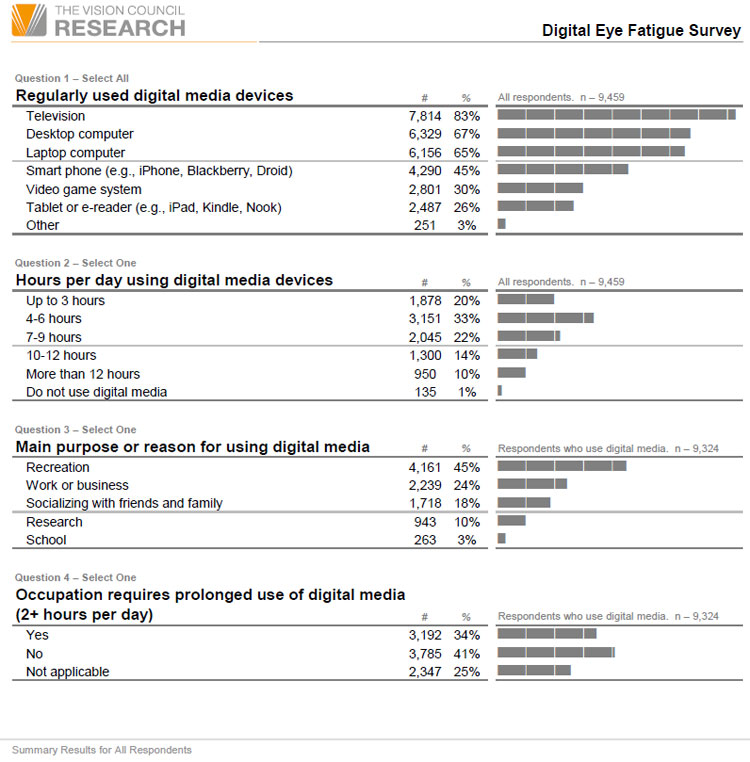By CLICK Staff
NEW YORK—It's likely your goal that your patients find your practice, your retail boutique or optical dispensary when they go online via their laptop, tablet or smartphone. But what's the impact of the tremendous explosion in the use of digital devices on people's vision?
A special report issued this year, the 2012 Digital Eye Fatigue Report, put out by
The Vision Council and VisionWatch, explores this phenomenon. VisionWatch, an on-going study of a statistically balanced sample of 110,000 U.S. residents designed to be representative of the U.S. population 18 years of age and older, used a questionnaire of 16 questions regarding the use of digital media devices and any related effects on vision from their extended use, to its May 2012 survey and it was based on a total sample of 9,459 American adults. The VisionWatch database was used to generate a series of detailed cross tabulations to highlight demographic differences between segments of the U.S. population.
 |
According to the summary of the report, which is available to Vision Council members, regular television usage is the predominant device used among all groups studied, with 83 percent of all respondents reporting regular use. Unsurprisingly, television usage is highest among recreational users. Desktop and laptop usage follows at 67 percent and 65 percent respectively. Notably, those using their devices for school and all adults under 35 use laptops more than desktops. Older adults, especially those above 55, and those using their devices primarily for business purposes use desktops more commonly than others.
Similarly, younger adults report regular use of smart phones and video game systems in far greater numbers than older adults. In fact, for 18-34 year olds, smart phone usage (66 percent) is three times as common as among those 55 and older (22 percent). Video game system usage has an even greater disparity with near half, 49 percent, of 18-34 years regularly using them compared to just 10 percent of 55+ adults.
Usage of tablets or e-readers among those younger than 55 is similar with 30 percent usage for both 18-34 and 35-44 year olds and 28 percent for those 45-54. Just 20 percent of adults 55 and older report regularly tablet or e-reader usage. Interestingly, usage by women, 31 percent, is ten points higher than men, 21 pecent.
Those using devices primarily for work or business report high usage of many devices, notably smart phones, 56 percent, and tablets, 34 percent, as well as regular computer usage. This corresponds with higher income households reporting higher usage of all devices than those with lower incomes.
Daily usage of digital media devices peaks in the 4 to 6 hour range for all groups at 33 percent. Just over half, 53 percent, of all respondents report daily use of 6 hours or less. The amount of daily use was remarkably similar among almost all groups. Those using the devices primarily for research purposes use these devices the least, with 66 percent reporting less than 6 hours daily use. Business users report the most use, with 59 percent reporting more than 6 hours daily use. The youngest respondents, 18-34, have the highest percentage using devices more than 12 hours daily, 14 percent. At the other end of the spectrum, the oldest group, 55 and older, has the highest percentage of less than 3 hours daily use, 24 percent.
Over two-thirds (69 percent) of digital media using respondents report issues during prolonged use of digital media devices. Most commonly neck and shoulder pain along with eye strain are each experienced by about one-third of respondents. Dry eyes, blurred vision, or headaches are each experienced by about a fifth of respondents. Women reported experiencing issues far more commonly than men – between 6 percent and 16 percent higher. Most older adults, likely because of less prolonged use of digital media, report the fewest issues. All required by their occupation to use digital media for more than 2 hours a daily, those who typically use digital media more than 6 hours daily as well as those using smart phones, game systems and tablets or e-readers report more issues across the board.
Few people (8 percent) have been stopped from an activity by eye issues related to digital media use. Those using devices primarily for school reported more disruptions, with 14 percent reporting being stopped from an activity by these eye issues.
While almost half of those with children at home (47 percent) are somewhat concerned about the effects of digital media on their children's eyes, less were very concerned (16 percent) than not concerned at all (37 percent). These findings were remarkably consistent across most demographic groups.
Almost one-fifth (19 percent) of respondents had not heard of the term "Digital Eye Fatigue." Familiarity with the term negatively correlated with age – that is, as age increased, fewer knew the term. Users of additional devices, like smart phones, video game systems, and tablets or e-readers, were also more likely to have heard the term (22-23 percent).
Fewer respondents were familiar with the term "Computer Vision Syndrome" than" Digital Eye Fatigue", just 12 percent. Little variation in knowledge of the term exists across demographic groups. More info about the report is available from Shawn Shafer at The Vision Council at 703-740-2252.
Back to Newsletter